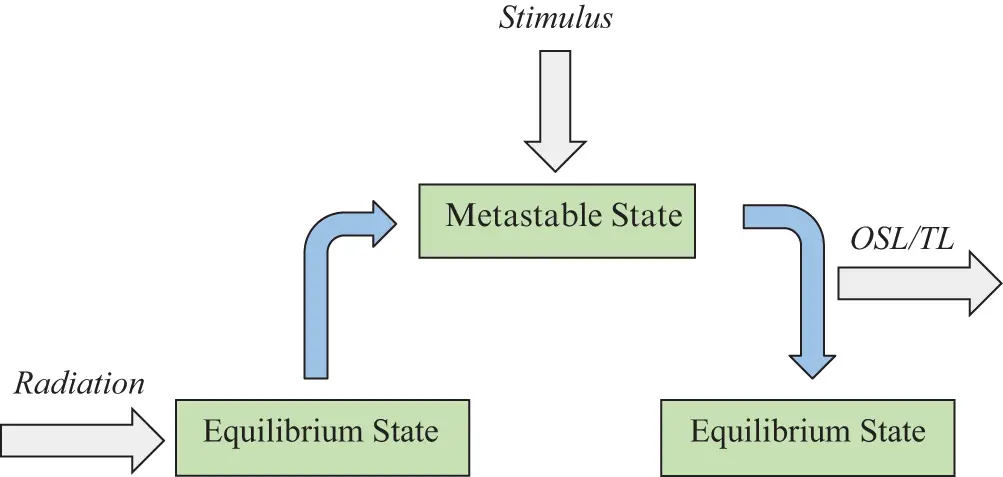Landmark developments in the use of TL, OSL, and RPL in dosimetry have been scattered over many decades, beginning with the study of radioactivity. To understand where the field resides at present – and to ensure that one does not “re-invent the wheel” – familiarity with this background is very important. Some of the highlights and seminal papers have been referenced here; many other important publications are available.
Choose one of the three dosimetry methods – TL, OSL, or RPL – and perform a bibliography search to trace the development of the technique from its earliest beginnings to its present-day use.
1.2 Introductory Concepts for TL, OSL, and RPL
1.2.1 Equilibrium and Metastable States
Consider a luminescence dosimetry material in its equilibrium state (Figure 1.1) in which all electrons are in their equilibrium energy levels. Perturbation from the equilibrium state by absorption of energy from an external energy source (radiation) raises the system to a metastable state, in which some electrons now occupy higher, non-equilibrium energy levels. The metastable state is characterized by potential energy barrier(s), which need(s) to be overcome before the system can return to equilibrium. The system may be stable in the metastable state from fractions of a second to thousands of years, depending on the size of the potential energy barrier(s). Absorption by the system of energy from an external stimulus while in the metastable state can overcome the potential barrier(s) and cause the system to relax to its stable equilibrium state. The stored energy may then be released, usually in the form of heat, but a portion of it may be released in the form of visible light and, thus, luminescence may be emitted. The intensity of the luminescence is related to the amount of energy initially absorbed during the irradiation phase. If the stimulus provided is in the form of heat energy, the luminescence emission is TL. If the stimulus involves the absorption of optical energy, the luminescence emission is OSL. (An animated version of Figure 1.1 is given on the web site, under Exercises and Notes, Chapter 1.)

Figure 1.1 Conceptual notion of TL and OSL in which a system in an equilibrium state is perturbed from that state to a metastable state through the absorption of energy from radiation. Once a stimulus is applied, in the form of heat or light, the system is triggered to return to equilibrium, along with the release of a portion of the absorbed energy in the form of light. If the stimulus is heat, the light emission is TL; if the stimulus is light, the emission is OSL. An animated version of this figure is available on the web site, under Exercises and Notes, Chapter 1.
To examine the nature of the equilibrium and metastable states it is necessary to consider the energy band gap of the material and Fermi-Dirac statistics.
1.2.2 Fermi-Dirac Statistics
Insulators and semiconductors are characterized by an energy gap between the uppermost filled energy band (the valence band) and the next empty band (the conduction band). At absolute zero, the valence band is completely full and the conduction band is completely empty. For a “perfect” crystal, no energy states are allowed in the energy gap between the top of the valence band (at energy Ev ) and the bottom of the conduction band (at energy Ec ). That is, if Z ( E ) is the density of available states at any energy E , then Z ( E ) = 0 for Ev < E < Ec , and the energy gap ( Ec – Ev ) is known as the “forbidden” gap or zone. However, real crystals contain defects such that Z ( E ) ≠ 0 in this forbidden zone. Energy states E can exist for which Ev < E < Ec and Z ( E ) > 0, and electrons can occupy energy states that are above the valence band but below the conduction band. Since such energy levels arise because of defects (e.g., impurities, vacancies, interstitials, and larger defect complexes), these states are localized at specific lattice sites within the crystal whereas the conduction and valence bands are delocalized. As a result, excitation of valence band electrons to one of these higher energy states, through the absorption of energy from a radiation field, requires not just a transition to a higher, excited energy level, but it also requires transport of the electron from one atomic or molecular site to another within the host crystal. That is, movement through the crystal is needed. This can only occur via a “transfer state” – in other words, via the conduction band (Figure 1.2a). Once the excited electrons have been transported to their new positions in the lattice, they relax into lower energy levels E , where Ev < E < Ec .

Figure 1.2 (a) Excitation from the equilibrium state (valence band) to the metastable state, via the conduction (“transport”) band. Stimulation from the metastable state results in recombination and relaxation to the equilibrium state, again via the conduction band. (b) The metastable state can be thought of as two energy levels within the energy band gap, one above the Fermi Level and one below. At equilibrium, all energy levels above the Fermi Level are empty and all levels below the Fermi Level are full. Excitation of electrons to the conduction band results in “trapping” at localized states, above the Fermi Levels. Similarly, holes are localized (“trapped”) at states below the Fermi Level. This is a non-equilibrium condition and represents the system in a metastable condition. Stimulation of the electron (say) from the localized state results in its recombination with the localized hole and the return of the system to equilibrium. Transitions: (1) Excitation (radiation); (2) Localization (trapping); (3) Stimulation (heat or light); (4) Relaxation (recombination). Animated versions of Figures 1.2a and 1.2b are available on the web site, under Exercises and Notes, Chapter 1.
This description is only partially complete, however. Since electrons have been excited out of the valence band, delocalized electronic holes are created. These positive charge species can move via the valence band states until they too become localized at defects within the lattice. In effect, this can be considered as an electron from the defect transitioning to the valence band, or as a hole from the valence band transitioning to the defect. The net result is that a hole, that is, a lack of an electron, now exists at that localized state.
If the two localized states just described – i.e., the localized electron state and the localized hole state – are the same, that is to say at the same defect, then the electron and hole will recombine and the whole system will return directly to its equilibrium state. However, if the two localized states are at different defects (different defect types) then they will remain localized and the system will no longer be in equilibrium. This is the metastable state.
The situation is illustrated in Figure 1.2b. (Animated versions of Figures 1.2a and 1.2b are available on the web site under Exercises and Notes, Chapter 1.) The two localized energy states, one above the Fermi Level and one below, localize excited electrons from the conduction band and free holes from the valence band, respectively. When localized in this way, the system is in a metastable condition. Absorption of energy from an external stimulus can free electrons (say) from the trap causing a transition to the conduction band, and these may subsequently recombine with the trapped holes, returning the system to equilibrium.
Читать дальше














